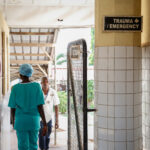- The two-monthly HIV prevention injection, CAB-LA, will be made in South Africa, at the Indian drug company Cipla’s Benoni and Durban plants. But a start date for production hasn’t yet been announced.
- Cipla is one of three Indian pharmaceutical companies who have been granted licences to produce cheaper, generic versions of ViiV Healthcare’s branded product.
- CAB-LA can virtually wipe out someone’s chances of contracting HIV through sex, but because it’s complex to manufacture and companies would need to implement and be trained on new technology, it could take between three and five years for generic products to become available.
- We look at the process and break down why intellectual property agreements and technology transfer are crucial to get medicines to people who need them most.
Although a start date hasn’t been announced, the South African arm of the Indian drug company Cipla has confirmed that a generic version of the two-monthly HIV prevention injection, CAB-LA (short for long-acting cabotegravir), will be made at its plants in Benoni or Durban.
Cabotegravir is an antiretroviral drug that blocks HIV from entering someone’s cells. Studies have shown that it virtually eliminates someone’s chances to get infected through sex and works better than a daily HIV prevention pill that’s available for free in South Africa — most likely because it’s easier to take it regularly.
The local manufacturing confirmation comes after an announcement in March by the developers of the branded version of the injection, ViiV Healthcare, and the Medicines Patent Pool (MPP) that sublicenses to produce a cheaper version of the drug have been granted to three companies, including Cipla, who has local manufacturing plants.
The other two companies who got licences — all Indian corporations already producing antiretroviral drugs for HIV treatment — are Auribindo and Viatris.
The Medicines Patent Pool is a United Nations-backed organisation that helps to negotiate licences for the generic production of medicines.
Cipla SA spokesperson, Fidelia van der Linde, says it’s not sure yet whether they will make the generic version of CAB-LA from scratch or import the main ingredient from overseas and then only mix and bottle it in South Africa. “However, most pharma companies in South Africa import their active [main] pharmaceutical ingredients,” she says.
The final packaging of a pharmaceutical product such as CAB-LA is, however, still a complicated process that requires sterile environments and new technology that would have to be set up.
Under the licence agreements, the generics companies will get ViiV’s CAB-LA recipe, as well as information on how to apply the recipe (called technology transfer).
The branded version of CAB-LA sells for about R67 000 a pop in the United States (at the current ZAR–USD exchange rate) — a price that is out of reach for lower-income countries. Even at a lower, “not-for-profit” price at which the manufacturer said it will sell the medicine to 90 poorer countries, including South Africa, the brand-name shot is likely to be too expensive for the government to buy.
[WATCH] ‘I’m a warrior’: How the anti-HIV injection empowers young women
While this price is not set yet, it could be around R4 600 per person per year (so, R767 per injection), Mitchell Warren, executive director of the Aids Vaccine Advocacy Coalition (Avac) told Bhekisisa. Avac is closely involved with the price negotiations.
As more stock is produced, because of larger orders, Mitchell says, the price may drop to below R3 700 per year (R617 per injection).
But even the “large-order” price might be more than double what a modelling study published in Lancet HIV has shown would be sensible for South Africa to pay. Researchers calculated that for CAB-LA to be cost effective for South Africa, the health department shouldn’t fork out more than double what they would have paid for two months’ supply of the daily HIV prevention pill per patient.
A month’s pills per patient costs the government R60 (this is only the cost of the pill and doesn’t include administrative fees such as health workers’ time, transport costs, etc). So, according to the study, the public health sector shouldn’t pay more than R240 (twice what the pills cost) per two-monthly shot (the study says between $9.03 and $14.47 based on USD-ZAR exchange rates at the time the research was published).
In December, Khadija Jamaloodien, the health department’s director of affordable medicine, told Bhekisisa that if a budget assessment (which was due to be completed by the end of March) showed that the government can afford branded CAB-LA, it will take about six months after a price had been agreed on before the jabs can be rolled out.
The health department did not respond to Bhekisisa’s requests about whether it had completed its budget assessment.
Having generic versions of a drug available means, in theory, that roll-out could be cheaper and faster. But being granted a licence to produce a generic version of a branded medicine is only the first step in getting cheaper options to people.
“CAB-LA is a sterile, injectable product with a very complex manufacturing process,” Kimberly Smith, ViiV Healthcare’s head of research and development, told Bhekisisa’s television programme, Health Beat, last year. This means that for a pharmaceutical company to make a generic version of a branded medicine, there needs to be tech transfer for them to learn how the process works. Having generics ready to sell will therefore not be immediate, but could take three to five years from the time that a licence has been granted until the product is market-ready.
But despite these obstacles, the CAB-LA deal is a reminder of how important intellectual property agreements and tech transfer are to get medicines to people who need them most, said Esteban Burrone, head of policy at the MPP, in a webinar hosted by Avac in April.
Here are four things to keep in mind.
1. More competitors mean lower drug prices
Medicines are protected by patents, which usually last for 20 years.

This means that a single company holds exclusive rights to manufacture and sell a product without competition in a country. It often leads to medicines being expensive, which means they could be out of reach for many people.
ViiV Healthcare holds the patent for CAB-LA until 2031.
But given licence agreements like the one with Cipla, more than one manufacturer can enter the market. Competition is good for consumers because companies are likely to drop their prices so that they can sell as much of their products as possible, explained Burrone. Without licences granted to other pharmaceutical companies to make generics, ViiV wouldn’t have had any competition for buyers for at least another eight years.
Even one new contender can have a dramatic impact on medicine prices, shows an analysis by the Food and Drug Administration, the medicines regulator in the United States.
They estimated that between 2015 and 2017, the price that wholesalers paid manufacturers for a drug dropped by 39% after one generic manufacturer came onto the market.
Products with six or more generic producers were, on average, 95% cheaper than when only a single branded option was available, the report shows.
2. More producers mean more people can get new medicines, faster
When there are more manufacturers producing a drug, there’s also enough to go around, Burrone explained. And at a cheaper price (because there’s more competition), governments in poorer nations are likely to buy it for their public sectors.
Take the medicine dolutegravir, for instance, also developed by ViiV. Dolutegravir is one of the antiretroviral drugs in a three-in-one pill that people with HIV take to reduce the virus to very low amounts in their bodies.
[WATCH] Health Beat #3 | Meet the first SA women to get the anti-HIV jab
Five years after ViiV and the MPP signed a voluntary licence agreement, 18 companies had licences to produce and sell cheaper, generic forms of dolutegravir in low-income countries, which are used by close to 6-million people.
In South Africa, for example, the government has announced that, in addition to newly diagnosed people, who already get dolutegravir as part of their treatment, all public sector HIV patients who are older than four weeks and who weigh more than three kilograms will switch to treatment plans that include dolutegravir from this year. Dolutegravir is better than efivarenz (the drug it replaced in the three-in-one pill) at getting the levels of HIV in someone’s blood so low that it can no longer be transmitted during sex (this is called viral suppression).
3. Intellectual property deals help to reduce drug shortages
Intellectual property deals like the one brokered by the MPP can also lessen the impact of medicine shortages, because alternative suppliers would be available should a company run out of stock.
But when there’s no such agreement, things can become dire in poorer countries.
An example of this was the short supply of vaccines during the COVID pandemic.
By late 2020, rich countries in Europe and North America had bought up most of the stock, produced by only a few manufacturers and who had exclusive rights to make vaccines. Had they agreed to waive their patents, more manufacturers would have been able to jump in and so boost supply to poorer countries.
By that time Canada had paid for enough jabs to vaccinate its population five times over, while the first doses for Africa were bought in early 2021, about a year after the pandemic hit, and were enough to vaccinate only around 9% of the continent’s population.
India and South Africa led a campaign at the World Trade Organisation to have intellectual property rights on COVID vaccines, medicines and diagnostic tools (such as tests) waived automatically for as long as the pandemic continued. The proposal was that pharma companies would also have to explain how to make their jabs, instead of just saying what’s in it.
In June 2022, a watered-down version of the original proposal was accepted, but it only covered vaccines (until 2027) — no other preventive medicines, treatments or tests. And it only applied to patents, not tech transfer, which means that generics firms would be able to use an inventor company’s ingredient list for a vaccine, but they would have to figure out the process for making the drug themselves. This takes lots of expertise, funding and time.
Licence agreements for generics don’t completely remove the risk of short supplies, though, cautions Burrone.
The lower price at which generics are sold means that profit margins might not be as high as with branded medicines. Manufacturers may therefore not want to make the products and so a shortage of generics could still develop.
For this reason, manufacturers who want a sublicence have to agree that they will do their best to produce “broad access to the product” as soon as they are awarded manufacturing rights. For CAB-LA, Burrone says they “zoomed in on the three manufacturers who are most ready” to rapidly address the existing demand.
4. Public health wins when there are manufacturers in different regions of the world
Less than 40% of the medicines Africa needs can be made on the continent, and it’s estimated that only 38 countries have any drug makers. Where they do exist, the companies rarely make medicines from scratch.
When already-made and packaged medicines are imported, they can be pricey. It’s cheaper to import raw materials to make the medicine locally than it is to ship in a finished product, according to calculations by the international consulting firm McKinsey & Company.
For example, in a cost model for Ethiopia, the firm found that to import a finished over-the-counter medicine from India would cost 12% more than to make it locally from scratch. Moreover, the imported product’s price would include a 20% mark-up to cover the cost of getting it to the distributor, which is much higher than if the medicine was made locally.
But to get these benefits, Burrone warns that the original developers would need to agree to offer tech transfer as part of the licence agreements so that generics companies can build up the expertise to manufacture drugs with complex recipes locally.
[Update 2023/05/11 12:49]: This article was updated to reflect that the anti-HIV injection could be made at Cipla South Africa’s plants in Durban or Benoni. An earlier version of the piece stated the jab will be made at both sites.
Zano Kunene is a health journalist at Bhekisisa.






